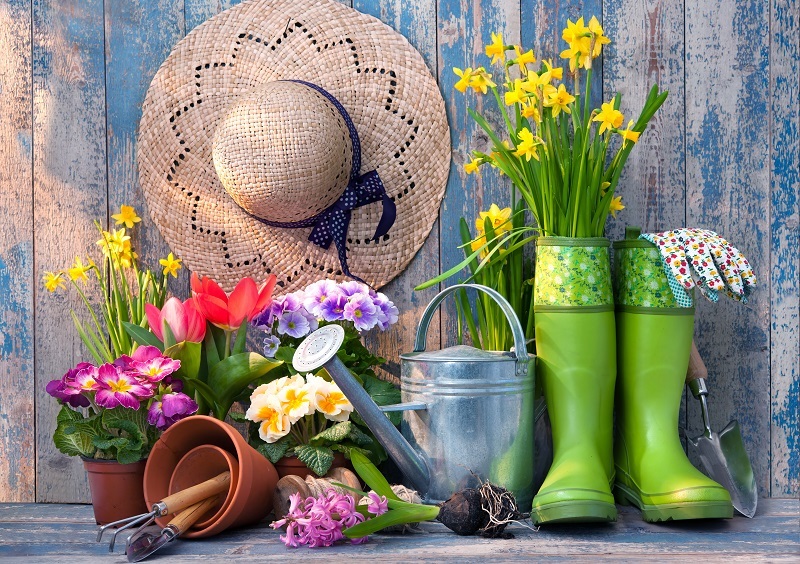Discover the Symbolism of Your Birth Flower and Its Insight
Posted on 02/07/2025
Discover the Symbolism of Your Birth Flower and Its Insight
Did you know that every month has its own unique birth flower with beautiful symbolism and insight? Throughout history, birth flowers have played a significant role in various cultures around the world, much like birthstones. These floral emblems are believed to reveal deep characteristics about individuals born in their respective months, and can offer profound insight into your personality, luck, and even life's journey. If you're curious about the meaning behind your birth flower, this comprehensive guide will take you on a journey of discovery--helping you unlock the secrets and symbolism of your birth month's blossoming representative.

What Are Birth Flowers?
The concept of birth flowers builds on the fascination humans have held for flowers for centuries. Each month of the year is associated with one or more flowers, each bearing its own meanings and virtues. Similar to zodiac signs and birthstones, birth month flowers are thought to be indicative of the qualities and characteristics that shape each individual's personality.
- January: Carnation or Snowdrop
- February: Violet or Primrose
- March: Daffodil or Jonquil
- April: Daisy or Sweet Pea
- May: Lily of the Valley or Hawthorn
- June: Rose or Honeysuckle
- July: Larkspur or Water Lily
- August: Gladiolus or Poppy
- September: Aster or Morning Glory
- October: Marigold or Cosmos
- November: Chrysanthemum
- December: Narcissus or Holly
Whether you're curious about your own birth flower or looking for a unique, meaningful gift for a loved one, understanding birth flower meanings lends a touch of personal magic to every occasion.
Birth Flower Meanings: A Month-by-Month Guide
January: Carnation & Snowdrop
Carnation: This delicate and ruffled blossom is the primary birth flower for January. Symbolizing love, fascination, and distinction, carnations are often linked to devotion and admiration. The different colors of carnations also convey nuanced meanings--pink denotes gratitude, red symbolizes deep love, and white expresses purity.
Snowdrop: The snowdrop, with its delicate white petals, emerges bravely through winter's snow, representing hope, new beginnings, and resilience. January-born individuals are often seen as tenacious, courageous, and optimistic.
February: Violet & Primrose
Violet: Associated with loyalty, modesty, and faithfulness, violets are the quintessential birth flower of February. This flower reflects the gentle and sincere nature of February-born people, who are often known for their integrity and humility.
Primrose: Symbolizing young love and innocence, the primrose flowers often hint at deep affection and the promise of new growth.
March: Daffodil & Jonquil
Daffodil: Bright and sunny, daffodils are known to symbolize rebirth, renewal, and new beginnings. March-born individuals often bring joy and optimism to those around them. They possess a natural charm and a cheerful demeanor.
Jonquil: Also representing affection and desire, jonquils are a variety of daffodil that add an extra layer of warmth and receptivity to March birthdays.
April: Daisy & Sweet Pea
Daisy: Daisies embody innocence, purity, and true love. People born in April are thought to be honest, loyal, and filled with a childlike joy.
Sweet Pea: Symbolizing blissful pleasure, sweet peas are known for their sweet fragrance and delicate beauty, often marking gratitude and kind goodbyes.
May: Lily of the Valley & Hawthorn
Lily of the Valley: The tiny, bell-shaped blossoms of Lily of the Valley represent humility, sweetness, and a return to happiness. May-born individuals often embody compassion, kindness, and a gentle spirit.
Hawthorn: Associated with hope and supreme happiness, hawthorn flowers also resonate with May's spirit of blossoming and growth.
June: Rose & Honeysuckle
Rose: Easily one of the most celebrated birth flowers, the rose captivates with its symbolism of love, passion, and beauty. Each color of rose conveys a different message--red for love, white for purity, yellow for friendship, and pink for admiration.
Honeysuckle: With its sweet fragrance, honeysuckle represents devoted affection and bonds that last. June-born individuals are said to possess loving, enduring spirits.
July: Larkspur & Water Lily
Larkspur: These vibrant blooms signify positivity, dignity, and an open heart. July-born individuals are often seen as generous and uplifting presences.
Water Lily: Water lilies embody purity and enlightenment, symbolizing the capacity to rise above life's challenges while remaining serene and beautiful.
August: Gladiolus & Poppy
Gladiolus: The gladiolus, often called the "sword lily," stands for strength, integrity, and remembrance. Those born in August are believed to be strong-willed, moral, and passionate about their beliefs.
Poppy: Poppies evoke themes of imagination and eternal sleep, but also symbolize peace, rest, and remembrance, adding a dreamy quality to August personalities.
September: Aster & Morning Glory
Aster: Aster flowers symbolize wisdom, valor, and faith. September-born individuals are often admired for their depth of understanding and inner strength.
Morning Glory: Representing affection and love in vain, morning glories open anew each morning, signifying renewal and the opportunity to start afresh.
October: Marigold & Cosmos
Marigold: Marigolds represent warmth, creativity, and the drive for success. Those born in October are energetic, enthusiastic, and determined to shine even when circumstances seem challenging.
Cosmos: Cosmos signify order, harmony, and tranquility, reminding October-born folks to seek balance and peace.
November: Chrysanthemum
Chrysanthemum: A beloved autumn blossom, chrysanthemums symbolize friendship, honesty, and joy. November-born individuals often spread happiness, sincerity, and loyalty among their friends and family.
December: Narcissus & Holly
Narcissus: Usually the paperwhite variety, these flowers stand for hope, respect, and new beginnings. December people are optimistic, resourceful, and inspiring.
Holly: Holly represents protection and domestic happiness, imbuing December with festive cheer, goodwill, and resilience.
The Unique Symbolism of Birth Flowers Across Cultures
The language of flowers, also known as floriography, varies across different traditions. In Victorian England, for example, bouquets were used to send secret messages, each flower choice laden with personal meaning. Meanwhile, in the Eastern traditions, certain blooms are linked to prosperity, longevity, or romantic fulfillment. Your birth flower's symbolism may carry different nuances depending on cultural context, but its essence remains a source of personal reflection and pride.
Why Discover the Symbolism of Your Birth Flower?
- Personal insight: Birth flower meanings can illuminate core strengths, values, or aspirations you may already sense within yourself or inspire new paths to explore.
- Unique gift ideas: Gifting someone their birth flower (or a floral arrangement featuring it) creates a meaningful and personalized gesture for birthdays and milestones.
- Floral decor inspiration: Incorporate your special bloom into your living space, wedding bouquets, or even tattoos for a touch of personal magic.
- Cultural connections: Understanding your birth flower's symbolism connects you with ancient traditions, family heritage, and a worldwide appreciation of nature's beauty.
How Can You Use Your Birth Flower's Insight?
Once you've discovered the symbolism behind your birth flower, there are many ways you can embrace its message:
- Self-reflection: Meditate on the meanings of your birth flower. Are there qualities that resonate with your personal journey?
- Journaling: Write about how your flower's qualities show up in your daily life and relationships.
- Creative inspiration: Use your birth flower as a motif in art, poetry, or crafts, from painting and jewelry to embroidery or garden planning.
- Spiritual growth: Some find that focusing on their birth flower's virtues during meditation or visualization helps reinforce positivity, confidence, or healing energies.
Birth Flower Symbolism for Relationships and Well-being
Flowers have always played a vital role in human connection and emotional expression. Learning the symbolism of your, or someone else's, birth flower can enhance your relationships by allowing for more heartfelt gestures. Whether you're acknowledging a friend's loyalty with a bouquet of chrysanthemums or expressing gratitude to a loved one with a bunch of pink carnations, choosing the right flower demonstrates empathy and personal attention.
Matching Birth Flowers to Personality Traits
Curious about how each birth month flower reflects unique personality insights? Here's a quick overview of some signature characteristics associated with each:
- January Carnation: Persevering and loving
- February Violet: Modest and faithful
- March Daffodil: Optimistic and cheerful
- April Daisy: Honest and joyful
- May Lily of the Valley: Sweet and caring
- June Rose: Romantic and passionate
- July Larkspur: Enthusiastic and supportive
- August Gladiolus: Strong and determined
- September Aster: Wise and reflective
- October Marigold: Creative and resilient
- November Chrysanthemum: Loyal and trustworthy
- December Narcissus: Inspiring and hopeful

How to Find and Celebrate Your Birth Flower
Finding your birth month flower is easy with guides like this, but there are many creative ways to celebrate and bring its insight into your life:
- Birth flower jewelry: Wear a pendant, ring, or bracelet featuring your symbolic bloom.
- Personalized gifts: Give art prints, stationery, or keepsakes adorned with a friend's birth flower.
- Gardening: Grow your birth flower in your home or garden as a living tribute to your personality and history.
- Special celebrations: Include birth flowers in birthday bouquets, cakes, or party decorations for a personalized touch.
The Timeless Power of Birth Flowers
Birth flowers continue to captivate and inspire people all over the world. Their symbolic language evolves with each culture and generation, providing a timeless connection between nature and personal identity. By understanding and embracing the meaning of your birth flower, you open a window to self-discovery and purposeful living.
As you explore the symbolism of your birth flower and its insight, remember that these beautiful blooms--rooted in tradition and brimming with meaning--offer a daily reminder of your unique gifts and the ever-unfolding story of your life.
Conclusion: Embrace Your Birth Flower's Meaning and Insight
From creating meaningful connections to inspiring daily self-reflection, the significance of your birth flower can enrich every aspect of your journey. As you uncover the secrets behind your birth month flower, let its symbolism guide you with wisdom and beauty. Whether you display it proudly, gift it thoughtfully, or simply contemplate its meaning, your birth flower is a living symbol of who you are--and the vibrant possibilities that lie ahead.
Start your journey today--discover the symbolism of your birth flower and its insight to cultivate a deeper understanding of yourself and the world around you.
Latest Posts
The Surprising Benefits of Fresh Flowers on Your Mood
A Step-by-Step Guide to Orchid Care
Guide to Nurturing Cut Flowers







